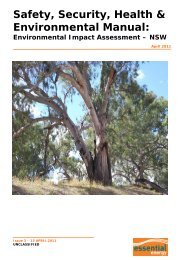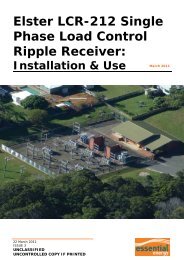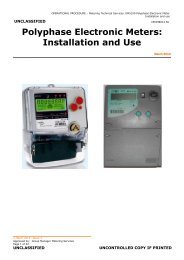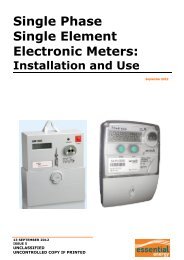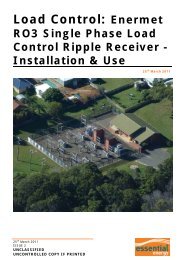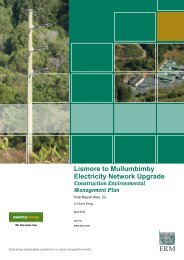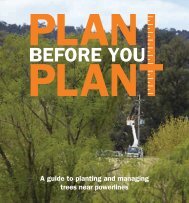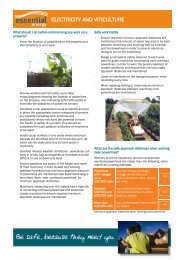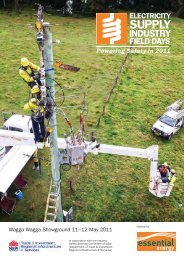CEOP8079 - Connection Guidelines - Essential Energy
CEOP8079 - Connection Guidelines - Essential Energy
CEOP8079 - Connection Guidelines - Essential Energy
Create successful ePaper yourself
Turn your PDF publications into a flip-book with our unique Google optimized e-Paper software.
UNCLASSIFIED<br />
OPERATIONAL PROCEDURE – <strong>Connection</strong> <strong>Guidelines</strong> for High<br />
Voltage <strong>Connection</strong>s and Embedded Generators<br />
<strong>CEOP8079</strong><br />
Communication systems<br />
Substation batteries and battery chargers<br />
Building / substation low voltage services<br />
Generator performance<br />
HV cables<br />
HV transmission lines.<br />
12.3.5 Acceptance Testing by <strong>Essential</strong> <strong>Energy</strong><br />
Once the <strong>Connection</strong> Applicant has successfully completed the commissioning tests,<br />
<strong>Essential</strong> <strong>Energy</strong> may elect to do an alternative test to satisfy its own requirements. Any<br />
discrepancies will need to be rectified by the <strong>Connection</strong> Applicant. Only after <strong>Essential</strong><br />
<strong>Energy</strong>‟s acceptance tests have been completed will the asset be allowed to be energised.<br />
12.4 Handover and Defects Liability Period<br />
"Handover" of the electricity works from the <strong>Connection</strong> Applicant to <strong>Essential</strong> <strong>Energy</strong> will<br />
occur on practical completion (as that term is defined in the relevant contract). The defects<br />
liability period will commence on the date of practical completion and will end on the<br />
expiration of the period specified in the contract after the date of practical completion (or if<br />
there a several such periods, for example where there are separable portions, the last to<br />
expire).<br />
During the defects liability period, <strong>Essential</strong> <strong>Energy</strong> may direct the <strong>Connection</strong> Applicant to<br />
rectify any defects in the electricity works. The contract may allow <strong>Essential</strong> <strong>Energy</strong> to direct<br />
the time within which the <strong>Connection</strong> Applicant must commence and complete the<br />
rectification of defect. <strong>Essential</strong> <strong>Energy</strong> may also set a further defects liability period in<br />
respect of work rectified - that period being effective from the date of rectification for a<br />
period specified by <strong>Essential</strong> <strong>Energy</strong>.<br />
While security held by <strong>Essential</strong> <strong>Energy</strong> is usually reduced upon practical completion, the<br />
remainder of the security should be held until the later of the issue of the final certificate<br />
under the contract (which occurs after the expiry of the defects liability period) and date on<br />
which all defects identified during the defects liability period have been rectified.<br />
13 HV ASSETS TO BE OWNED AND OPERATED BY OTHERS<br />
In addition to the requirements listed under Section 11, of these <strong>Guidelines</strong> the following<br />
requirements must be complied with for all assets to be owned and operated by others.<br />
13.1 Design, Equipment and Materials<br />
All design details must be endorsed by a Level 3 ASP to meet the requirements of AS/NZS<br />
3000 Australia/New Zealand Wiring Rules, the NSW S & I Rules and AS/NZS 7000:2010<br />
Overhead line design – Detailed procedures.<br />
13.2 Design References<br />
13.2.1 Transmission, Zone and Switching Stations<br />
HV assets must meet the requirements of AS/NZS 3000 Australian/New Zealand Wiring<br />
Rules, and the NSW S & I Rules.<br />
23 November 2012 - Issue 7<br />
Approved By: Group Manager Major Customer Engagement<br />
Page 25 of 36<br />
UNCLASSIFIED<br />
UNCONTROLLED COPY IF PRINTED




